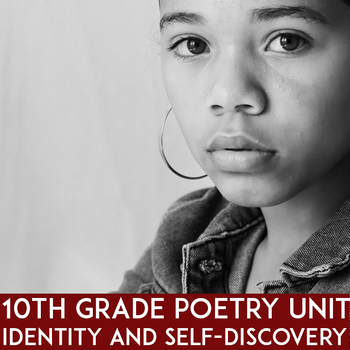10th Grade ELA Curriculum: High School Poetry Unit | Literary Analysis | English
- Zip
Description
Tired of students groaning and rolling their eyes whenever they hear the word “poetry”?
You can’t really be surprised they act this way when they’ve been lead to believe that reading poetry means trying to figure out some inane, irrelevant puzzle. And when they’ve only experienced poetry written by old white men who died one hundred years ago, it’s no wonder that they are bored out of their minds.
On the other hand, poetry units that are billed as fun and entertaining are often just flashy, vacant slideshows or fancy handouts that look pretty but don’t actually help students develop any of the skills they need. Students will quickly see through this kind of lesson plan as well.
If you want to teach a poetry unit that reaches jaded teens and challenges them to find their full potential, you need relatable poetry, scaffolded lessons, and innovative activities. When you build students’ independence, skills, and confidence, they will learn that real poetry analysis can be fun. Beyond just fulfilling a standards requirement, great poetry helps us to talk about our own experiences, to understand others on a deeper level, and to more fully appreciate the world around us.
The poets included in this resource—Edna St Vincent Millay, Rudy Francisco, Maya Angelou, Gwendolyn Brooks, Langston Hughes, Robert Frost, Adrienne Rich, William Ernest Henley, and Audre Lorde—are perennial student favorites and great choices for teen poetry readers.
Focusing on themes of identity and self-discover, this 5-week poetry unit explores experiences, emotions, and ideas that are relevant to 10th graders as they start to figure out who they are and what they want the world to know about them. The poems in this unit offer students windows on experiences unlike their own and mirrors to see themselves in literature.
This unit is also easy on you as the teacher—it’s both low-key and standards-aligned. The no-prep handouts and engaging high-interest activities will give you a break from planning and constant managing of your classes while still maintaining rigor.
When you teach this innovative, fun, and rigorous poetry unit with your classes you will:
- Easily plan five weeks of engaging lesson plans when you utilize the pacing guide included in the bonus materials.
- Start your unit off with a bang with two engaging, short poems.
- Start your class periods with a bellringer freewrites prompts that will help students to focus, get ready to work, and begin to explore the essential questions of the texts.
- Strengthen your students’ close reading skills by taking them through close readings of the poems with the no-prep questions and handouts.
- Empower different learning styles with quiet reflection, group work, creative writing, presentations, jigsaw activities, and dynamic discussion questions.
- Get your classes to understand poetic elements from the inside out when they experiment with poetry writing by utilizing the innovative exercises.
- Add rigor to your lesson plans when your students analyze the poetic elements of the poems with the structured and focused questions.
- Find the best fit to teach poetry in your yearly plans when you teach a full unit focused on poetry or break out the stand-alone units to teach throughout the year.
- Get even your most reluctant learners writing poetry of their own with the fun, structured poetry imitation assignments.
- Help your classes move towards independent poetry analysis with the scaffolded and structured questions, activities, and assignments all focused on how poets create meaning with poetic elements.
- Easily review the questions using the extensive answer keys which quote the important passages, so there is no guessing on your part as to which parts of the texts are most important.
- Get your students writing frequently with the engaging prompts, meaningful essays, and engaging creative writing assignments.
- Help your classes improve their literary analysis writing, poetry analysis, and poetry writing when you utilize the 30-page bonus file including writing workshop guides, peer conference handouts, poetry analysis guides, and more.
- Challenge your students to become independent thinkers, find their own voices, and learn that words can be sources of joy and inspiration when they learn to analyze independently, write poetry of their own, and engage in fun activities.
Pairings: These poems would pair well with novels and plays that deal with themes of identity, resilience, hardship, self-empowerment, or self-discovery such as The Awakening, Black Boy, Cold Mountain, The Color Purple, Crime and Punishment, Death of a Salesman, A Doll House, Frankenstein, Grendel, Hamlet, The Iliad, Julius Caesar, Lord of the Flies, MacBeth, Medea, The Odyssey, Othello, Things Fall Apart, or Wuthering Heights, The House on Mango Street, A Raisin in the Sun, To Kill a Mockingbird, or The Adventures of Huckleberry Finn.





